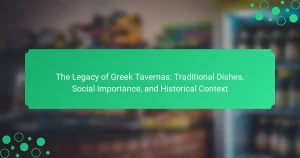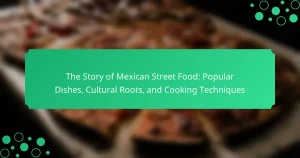Spanish tapas are small dishes or appetizers that play a significant role in the country’s culinary culture. Originating in the 13th century, the tradition of tapas began as a way to promote social dining and prevent excessive drinking. This article explores the history of tapas, highlighting popular ingredients such as cecina, espárragos blancos, and pimientos de padrón, which vary by region. Additionally, it examines the evolution of tapas from simple snacks to a communal dining experience, reflecting Spain’s diverse gastronomic heritage. The discussion includes serving traditions and the importance of regional specialties in defining the tapas experience.

What are Spanish Tapas and Their Historical Significance?
Spanish tapas are small dishes or appetizers served in Spain. They can include a variety of foods, such as olives, cheese, and cured meats. The tradition of tapas dates back to the 13th century. It is believed that King Alfonso X of Castile popularized the practice of serving small snacks with drinks. This was intended to prevent drunkenness by keeping patrons from drinking on an empty stomach. Over time, tapas evolved into a social dining experience. They are often enjoyed in bars and restaurants, encouraging sharing among friends. Tapas reflect regional ingredients and culinary traditions across Spain. This diversity showcases the country’s rich gastronomic culture.
How did the tradition of tapas originate in Spain?
The tradition of tapas originated in Spain as a way to serve small portions of food. The term “tapa” means “lid” in Spanish. Historically, these small dishes were used to cover drinks, preventing flies from getting in. Over time, bars began offering these small snacks alongside beverages. The practice became popular in Andalusia during the 19th century. Tapas evolved into a social dining experience, encouraging sharing among friends. Today, tapas are a staple of Spanish cuisine, enjoyed in various forms across the country.
What historical events influenced the development of tapas?
The development of tapas was influenced by various historical events in Spain. The origin of tapas dates back to the 13th century during the reign of King Alfonso X. He mandated that wine be served with food to prevent drunkenness. This led to the practice of serving small dishes alongside drinks.
The Spanish Civil War in the 1930s also played a significant role. Food scarcity prompted the creation of simple, affordable dishes that could be shared. The post-war period saw a rise in social gatherings, further popularizing tapas as a communal dining experience.
Additionally, the rise of tourism in the late 20th century contributed to the global spread of tapas. International visitors sought authentic Spanish cuisine, leading to the establishment of tapas bars worldwide. Each of these events helped shape the tradition and variety of tapas as we know it today.
How have cultural exchanges shaped the evolution of tapas?
Cultural exchanges have significantly influenced the evolution of tapas. Historical interactions between Spain and various cultures introduced diverse ingredients and preparation methods. The Moors brought spices and cooking techniques that enriched Spanish cuisine. Trade with the Americas introduced new foods like tomatoes and peppers, which became staples in tapas. Additionally, the influx of tourists has led to the incorporation of international flavors into traditional dishes. These exchanges have resulted in a dynamic and evolving tapas culture that reflects both local and global influences.
What role do tapas play in Spanish cuisine today?
Tapas play a significant role in Spanish cuisine today as a cultural and social dining tradition. They are small dishes that encourage sharing and social interaction among diners. Tapas can vary widely, featuring ingredients such as olives, cheeses, and cured meats. They represent the regional diversity of Spain, with each area offering unique variations. Tapas are often enjoyed in bars and restaurants, enhancing the communal dining experience. The popularity of tapas has grown internationally, influencing global dining trends. This reflects their importance in promoting Spanish culinary heritage.
How are tapas integrated into social dining experiences in Spain?
Tapas are integral to social dining experiences in Spain. They encourage sharing and conversation among diners. Tapas are often served in small portions, promoting a communal atmosphere. This style allows groups to sample a variety of dishes. Traditional Spanish culture emphasizes social interaction during meals. Tapas are typically enjoyed in bars and restaurants, often accompanied by drinks. The practice of “ir de tapas” involves hopping between establishments. This enhances social engagement and fosters community connections. Overall, tapas play a crucial role in Spain’s culinary and social landscape.
What are the key characteristics that define traditional tapas?

What are the Most Popular Ingredients Used in Tapas?
Traditional tapas are small, shareable dishes that represent Spanish culinary culture. They are often served as appetizers or snacks, encouraging social interaction. Tapas can be hot or cold and vary widely in ingredients and preparation methods. Common characteristics include a focus on fresh, local ingredients and a balance of flavors. They are typically enjoyed with drinks, enhancing the communal dining experience. Tapas can also reflect regional specialties, showcasing local culinary traditions. The tradition of tapas is rooted in Spanish history, with origins dating back to the 13th century when they were used to cover drinks.
Which ingredients are commonly found in Spanish tapas?
Common ingredients found in Spanish tapas include olives, cheese, cured meats, and seafood. Olives are often marinated and served as a flavorful appetizer. Cheese varieties, like Manchego, add richness to the tapas experience. Cured meats, such as jamón ibérico, provide a savory element. Seafood options, including anchovies and calamari, are also popular. Vegetables like peppers and tomatoes are frequently incorporated. These ingredients reflect the diverse culinary traditions of Spain. They contribute to the social and communal aspect of dining on tapas.
What types of meats are typically used in tapas dishes?
Common types of meats used in tapas dishes include chorizo, jamón, and morcilla. Chorizo is a spicy sausage made from pork and paprika. Jamón, particularly jamón ibérico, is a high-quality cured ham from Spain. Morcilla is a blood sausage that often contains rice and spices. Other meats may include chicken, beef, and seafood in various preparations. These meats are typically served in small portions, allowing for a variety of flavors in a single meal.
How do vegetables and legumes contribute to the variety of tapas?
Vegetables and legumes enhance the variety of tapas by providing diverse flavors and textures. They serve as essential components in many traditional Spanish dishes. Common vegetables used include peppers, tomatoes, and eggplants. These ingredients are often grilled, roasted, or marinated to create vibrant tapas. Legumes, such as chickpeas and lentils, add protein and heartiness. Dishes like hummus or garbanzos con espinacas showcase their versatility. Seasonal vegetables also reflect regional variations in tapas. This variety caters to different dietary preferences, making tapas inclusive.
What unique ingredients are used in regional tapas variations?
Unique ingredients in regional tapas variations include chorizo in Andalusia, bacalao in the Basque Country, and escalivada in Catalonia. Chorizo is a spiced sausage that adds a rich flavor to dishes. Bacalao, or salted cod, is often featured in pintxos, small snacks in Basque cuisine. Escalivada consists of roasted vegetables, typically eggplant and peppers, served with olive oil. Each region showcases its local produce and culinary traditions. For instance, Valencia uses seafood prominently in tapas due to its coastal location. These unique ingredients reflect the diverse agricultural and cultural heritage across Spain.
How do local climates and agriculture influence ingredient selection?
Local climates and agriculture significantly influence ingredient selection in Spanish tapas. Regions with warmer climates produce a variety of fruits and vegetables. For example, Andalusia is known for its olives and citrus fruits due to its hot, dry weather. Cooler regions, like Galicia, focus on seafood and hearty vegetables. The availability of local produce shapes traditional recipes. Seasonal changes also dictate what ingredients are fresh and accessible. This results in diverse tapas reflecting regional agricultural practices. Consequently, local climates directly impact the flavors and ingredients used in tapas.
What are some rare or unique ingredients that define specific tapas?

What are the Different Serving Traditions of Tapas?
Cecina is a unique ingredient that defines specific tapas, particularly in the region of León. This air-dried cured meat, often made from beef, offers a distinct flavor profile. Another rare ingredient is espárragos blancos, or white asparagus, commonly used in tapas from Navarra. These asparagus are prized for their tender texture and delicate taste. Additionally, pimientos de padrón, small green peppers from Galicia, are known for their unique characteristic of sometimes being spicy. Each of these ingredients contributes to the authenticity and regional identity of tapas.
How are tapas traditionally served in Spain?
Tapas are traditionally served in Spain as small plates of food. They can be enjoyed as appetizers or snacks. Tapas are often shared among diners. This communal style encourages social interaction. They are typically served alongside drinks. Common beverages include wine, beer, or sherry. Tapas can vary by region, featuring local ingredients. Popular examples include olives, cheeses, and cured meats. The tradition of serving tapas dates back to the 13th century.
What are the various styles of serving tapas (e.g., individual plates vs. shared platters)?
Tapas can be served in various styles, primarily as individual plates or shared platters. Individual plates allow each guest to enjoy their own selection of tapas. This style promotes personal choice and tailored dining experiences. Shared platters, on the other hand, encourage communal eating. Guests can sample a variety of dishes together. This style fosters social interaction and a sense of togetherness. The choice between these styles often depends on the dining setting and cultural traditions. In Spain, shared platters are commonly preferred in casual settings, while individual plates may be seen in more formal dining.
How do serving traditions vary across different regions of Spain?
Serving traditions in Spain vary significantly by region. In Andalusia, tapas are often served as free accompaniments with drinks. In contrast, in Catalonia, tapas are typically ordered separately and can be more elaborate. The Basque Country features pintxos, where small snacks are skewered with toothpicks. Valencia emphasizes the communal aspect of dining, with shared dishes like paella. In Galicia, seafood tapas are prevalent, reflecting the region’s coastal resources. Each region’s serving style reflects local culture and culinary resources. These traditions contribute to the rich diversity of Spanish cuisine.
What etiquette is associated with enjoying tapas?
Tapas etiquette involves sharing dishes and enjoying them in a communal setting. Diners typically order several small plates to share among the group. It is customary to take small portions from each dish. Guests should avoid taking large servings for themselves. Eating tapas is often accompanied by socializing and conversation. It is polite to wait for everyone to be served before starting to eat. In Spain, it is common to stand while enjoying tapas in bars. Tipping is appreciated but not mandatory. These practices reflect the social and communal nature of tapas dining in Spanish culture.
How do social customs influence the way tapas are consumed?
Social customs significantly influence the consumption of tapas in Spain. Tapas are often enjoyed in social settings, promoting communal dining. This tradition encourages sharing and conversation among diners. In many regions, tapas are served as a pre-meal snack, fostering social interaction before main courses. Cultural events and festivals also play a role in tapas consumption, often featuring local specialties. Additionally, the timing of tapas consumption varies, typically enjoyed in the early evening. This aligns with Spanish customs of late dining. The practice of “tapeo,” or going out for tapas, is a common social activity. It reflects the value placed on community and connection in Spanish culture.
What are some common practices for pairing tapas with beverages?
How do Regional Variations Affect Tapas Culture?
Common practices for pairing tapas with beverages include matching flavors and textures. Light tapas often pair well with white wine or sparkling wine. Heavier dishes, like meat-based tapas, typically complement red wine. Beer is frequently enjoyed with fried tapas, such as calamari. In regions like Andalusia, sherry is a traditional pairing with various tapas. Pairing local beverages enhances the overall dining experience. These practices reflect cultural traditions and enhance flavor profiles.
What are the key regional differences in tapas recipes across Spain?
Key regional differences in tapas recipes across Spain include variations in ingredients and preparation methods. In Andalusia, seafood is prevalent, with dishes like pescaíto frito. In contrast, the Basque Country favors pintxos, which are small snacks often served on skewers. Catalonia features escalivada, a roasted vegetable dish, showcasing local produce. Valencia is known for its use of rice, incorporating it into tapas like arancini. In Madrid, traditional tapas include patatas bravas, a spicy potato dish. Each region reflects its local culture and available ingredients, creating a diverse culinary landscape across Spain.
How does the cuisine of Andalusia differ from that of Catalonia in terms of tapas?
Andalusian tapas typically emphasize seafood and fried dishes, reflecting the region’s coastal geography. Common tapas include fried fish, shrimp, and calamari. In contrast, Catalan tapas often feature cured meats, cheeses, and vegetable-based dishes. Examples include pan con tomate and various charcuterie. The use of olive oil is prominent in both regions, but Andalusia tends to use it in frying, while Catalonia incorporates it in dressings and marinades. This difference in ingredient focus highlights the unique culinary traditions of each region.
What are some signature tapas dishes unique to specific Spanish regions?
What Tips Can Enhance Your Tapas Experience?
Signature tapas dishes vary by region in Spain. In Andalusia, “Gambas al Pil Pil” features garlic shrimp in olive oil. In Catalonia, “Pan con Tomate” consists of bread topped with ripe tomatoes and olive oil. The Basque Country is known for “Pintxos,” small snacks often served on skewers. Valencia offers “Esqueixada,” a salad of salt cod and vegetables. Galicia specializes in “Pulpo a la Gallega,” octopus seasoned with paprika. These dishes reflect local ingredients and culinary traditions, showcasing Spain’s diverse gastronomy. Each region’s unique flavors contribute to the rich tapestry of Spanish tapas culture.
The main entity of the article is Spanish tapas, which are small dishes or appetizers integral to Spanish cuisine. The article explores the historical significance of tapas, tracing their origins back to the 13th century and highlighting their evolution into a social dining experience. It examines the various popular ingredients used in tapas, including olives, cheeses, and cured meats, as well as the unique regional variations that reflect local culinary traditions. Additionally, the article discusses serving traditions, etiquette, and the influence of cultural exchanges on the diversity of tapas, providing a comprehensive overview of this essential aspect of Spanish gastronomy.




